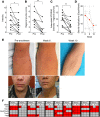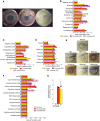First-in-human topical microbiome transplantation with Roseomonas mucosa for atopic dermatitis
- PMID: 29720571
- PMCID: PMC6012572
- DOI: 10.1172/jci.insight.120608
First-in-human topical microbiome transplantation with Roseomonas mucosa for atopic dermatitis
Abstract
The underlying pathology of atopic dermatitis (AD) includes impaired skin barrier function, susceptibility to Staphylococcus aureus skin infection, immune dysregulation, and cutaneous dysbiosis. Our recent investigation into the potential role of Gram-negative skin bacteria in AD revealed that isolates of one particular commensal, Roseomonas mucosa, collected from healthy volunteers (HVs) improved outcomes in mouse and cell culture models of AD. In contrast, isolates of R. mucosa from patients with AD worsened outcomes in these models. These preclinical results suggested that interventions targeting the microbiome could provide therapeutic benefit for patients with AD. As a first test of this hypothesis in humans, 10 adult and 5 pediatric patients were enrolled in an open-label phase I/II safety and activity trial (the Beginning Assessment of Cutaneous Treatment Efficacy for Roseomonas in Atopic Dermatitis trial; BACTERiAD I/II). Treatment with R. mucosa was associated with significant decreases in measures of disease severity, topical steroid requirement, and S. aureus burden. There were no adverse events or treatment complications. We additionally evaluated differentiating bacterial metabolites and topical exposures that may contribute to the skin dysbiosis associated with AD and/or influence future microbiome-based treatments. These early results support continued evaluation of R. mucosa therapy with a placebo-controlled trial.
Keywords: Allergy; Dermatology; Immunology; Skin.
Conflict of interest statement
Figures




Similar articles
-
Skin bacterial transplant in atopic dermatitis: Knowns, unknowns and emerging trends.J Dermatol Sci. 2019 Aug;95(2):56-61. doi: 10.1016/j.jdermsci.2019.07.001. Epub 2019 Jul 5. J Dermatol Sci. 2019. PMID: 31395434 Review.
-
Therapeutic responses to Roseomonas mucosa in atopic dermatitis may involve lipid-mediated TNF-related epithelial repair.Sci Transl Med. 2020 Sep 9;12(560):eaaz8631. doi: 10.1126/scitranslmed.aaz8631. Sci Transl Med. 2020. PMID: 32908007 Free PMC article. Clinical Trial.
-
Skin microbiome of atopic dermatitis.Allergol Int. 2022 Jan;71(1):31-39. doi: 10.1016/j.alit.2021.11.001. Epub 2021 Nov 24. Allergol Int. 2022. PMID: 34838450 Review.
-
Skin microbiome dysbiosis and the role of Staphylococcus aureus in atopic dermatitis in adults and children: A narrative review.J Eur Acad Dermatol Venereol. 2023 Jun;37 Suppl 5:3-17. doi: 10.1111/jdv.19125. J Eur Acad Dermatol Venereol. 2023. PMID: 37232427 Review.
-
The role of skin dysbiosis in atopic dermatitis.Eur J Dermatol. 2022 Jul 1;32(4):439-444. doi: 10.1684/ejd.2022.4289. Eur J Dermatol. 2022. PMID: 36301755 English.
Cited by
-
The role of the skin microbiome in atopic dermatitis.Ann Allergy Asthma Immunol. 2019 Mar;122(3):263-269. doi: 10.1016/j.anai.2018.12.003. Epub 2018 Dec 11. Ann Allergy Asthma Immunol. 2019. PMID: 30550810 Free PMC article. Review. No abstract available.
-
Consensus on the therapeutic management of atopic dermatitis - Brazilian Society of Dermatology.An Bras Dermatol. 2019 Apr;94(2 Suppl 1):67-75. doi: 10.1590/abd1806-4841.2019940210. Epub 2019 Jun 3. An Bras Dermatol. 2019. PMID: 31166406 Free PMC article.
-
Assessing the effects of common topical exposures on skin bacteria associated with atopic dermatitis.Skin Health Dis. 2021 Sep;1(3):e41. doi: 10.1002/ski2.41. Epub 2021 May 7. Skin Health Dis. 2021. PMID: 34723253 Free PMC article.
-
The skin microbiome in pediatric atopic dermatitis and food allergy.Allergy. 2024 Jun;79(6):1470-1484. doi: 10.1111/all.16044. Epub 2024 Feb 3. Allergy. 2024. PMID: 38308490 Free PMC article. Review.
-
Extrinsic Factors Shaping the Skin Microbiome.Microorganisms. 2020 Jul 10;8(7):1023. doi: 10.3390/microorganisms8071023. Microorganisms. 2020. PMID: 32664353 Free PMC article. Review.
References
-
- Eichenfield LF, Ahluwalia J, Waldman A, Borok J, Udkoff J, Boguniewicz M. Current guidelines for the evaluation and management of atopic dermatitis: A comparison of the Joint Task Force Practice Parameter and American Academy of Dermatology guidelines. J Allergy Clin Immunol. 2017;139(4S):S49–S57. - PubMed
-
- Latvala J, von Hertzen L, Lindholm H, Haahtela T. Trends in prevalence of asthma and allergy in Finnish young men: nationwide study, 1966-2003. BMJ. 2005;330(7501):1186–1187. doi: 10.1136/bmj.38448.603924.AE. - DOI - PMC - PubMed
Publication types
MeSH terms
Substances
LinkOut - more resources
Full Text Sources
Other Literature Sources
Medical
Molecular Biology Databases
Research Materials

